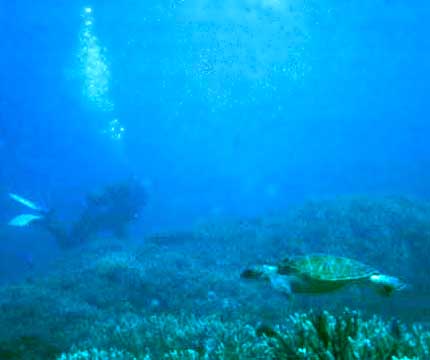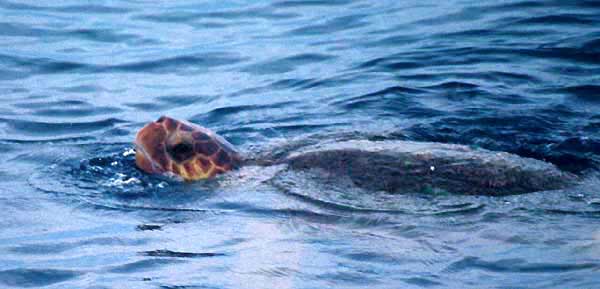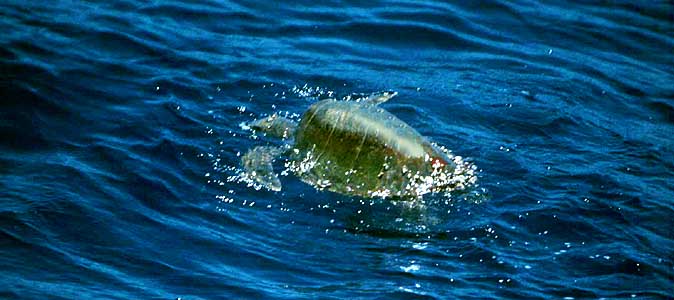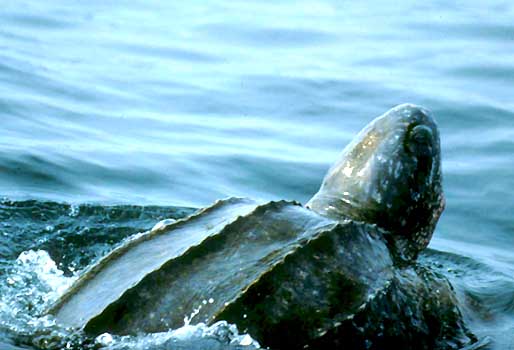SEA TURTLES Families
Cheloniidae
& Dermochelyidae
commentary by Don Roberson
The pelagic-going birdwatcher is in for a major treat if he or she comes
upon a sea turtle. Sea turtles are relics of one of the world's most ancient
vertebrate lineages, and seem prehistoric in many ways. Most their lives
are spent at sea; females alone come ashore on traditional beaches to lay
eggs. On these beaches they have been subjected to intense egg-predation
in recent years, not to mention the hazards faced by the tiny babies who
claw their way to the surface (often synchronously) and try to reach the
ocean past the hordes of predatory frigatebirds, egrets, vultures, and
other hazards. A February 1994 National Geographic article [Anne
& Jack Rudloe, photos by Bill Curtsinger, "Sea Turtles in a race for
survival"] highlights many of these problems. There are only 7-8 species
worldwide (taxonomists disagree on whether Green and Black sea-turtles
are separate species or subspecies; I consider them separate species here).
To see any of them is a treat. I've had the good fortune to observe six
of them to date, and present photos of five here. Beside those shown below,
I've encountered the Hawksbill Sea-turtle Eretmochelys imbricata
a couple times around coral reefs in the Caribbean (they nibble at the
coral). I have yet to see the endangered Kemp's Ridley Lepidochelys
kempii of the Caribbean, or the Australian Flatback Sea-turtle Natator
depressus of Australasia. All eight species of sea-turtles are threatened
or endangered.
Unless one visits the ancestral nesting beaches at the exact night when
females come ashore to lay eggs, observing sea-turtles is limited to shipboard
sightings at sea, or underwater encounters while SCUBA diving. I've done
the latter two, but have yet to experience the nesting beach phenomena.
All
photos © 2000 Don Roberson, except the upper Leatherback image which
is © 2000 John Sorensen and used with permission; all rights reserved.
Family Cheloniidae
The typical sea-turtles
 The
Green
Sea-turtle Chelonia mydas is found in tropical oceans around
the globe, except the eastern tropical Pacific where Black Sea-turtle is
the tropical species. It is often found close to shore in bays and lagoons,
and I've encountered in while diving in the Caribbean and on the Great
Barrier Reef, Australia [the underwater photo of Green Sea-Turtle,
right, is from Heron I. at the southern end of the Great Barrier Reef,
east of Townsville, Queensland, Australia, in Sep 1983]. It is a grazer,
feeding on beds of eel-grass or seaweed, or algae around mangroves. Migrational
movements take some of these beasts far offshore. It has perhaps the most
prized turtle meat, and now there are commercial turtle farms in lagoons
around the southern Caribbean. The largest natural nesting beach is at
Tortugera, Costa Rica.
The
Green
Sea-turtle Chelonia mydas is found in tropical oceans around
the globe, except the eastern tropical Pacific where Black Sea-turtle is
the tropical species. It is often found close to shore in bays and lagoons,
and I've encountered in while diving in the Caribbean and on the Great
Barrier Reef, Australia [the underwater photo of Green Sea-Turtle,
right, is from Heron I. at the southern end of the Great Barrier Reef,
east of Townsville, Queensland, Australia, in Sep 1983]. It is a grazer,
feeding on beds of eel-grass or seaweed, or algae around mangroves. Migrational
movements take some of these beasts far offshore. It has perhaps the most
prized turtle meat, and now there are commercial turtle farms in lagoons
around the southern Caribbean. The largest natural nesting beach is at
Tortugera, Costa Rica.
The name "Green Sea-Turtle" comes from the color of its fat, but the
carapace (shell) is often greenish to olive. It has a long prehensile tail.
Identification within its range is made by counting four costal shields
(the large plates on the sides of the shell, not to be confused with a
row of vertebral shields down the center of the carapace) and the two very
large prefrontal scales between the eye-lids.
 The
Black Sea-turtle Chelonia agassizi is the "Green Turtle" representative
in the eastern tropical Pacific. Like the Green, it is a grazer. It seems
most common around the Galapagos Island. Our research boat disturbed this
pair of Black Sea-turtles, left, just east of Española I.,
Galapagos, in Sep 1989. They were engaged in mating before our ship just
about ran them over. These mating sessions can last for hours if undisturbed
....
The
Black Sea-turtle Chelonia agassizi is the "Green Turtle" representative
in the eastern tropical Pacific. Like the Green, it is a grazer. It seems
most common around the Galapagos Island. Our research boat disturbed this
pair of Black Sea-turtles, left, just east of Española I.,
Galapagos, in Sep 1989. They were engaged in mating before our ship just
about ran them over. These mating sessions can last for hours if undisturbed
....
My brief experience with these turtles is that they do look dark --
essentially blackish -- compared to the more widespread Green Sea-Turtle.
Photos in the National Geographic article cited above tend
to support this idea. Their range extends to western Mexico and occasional
one will reach southern California (there are even a couple records from
Monterey Bay; Starbird et al. 1993). Like the Green Sea-Turtle, they have
two very large and very long prefrontal scales between the eyes, helping
to separate them from Loggerheads (which has two pairs of two scales on
the forehead; see the photo below).

The Loggerhead Sea-turtle Caretta caretta has a huge
head and heavy jaws used for crushing mollusks and crustaceans. This is
the most likely sea-turtle to be seen around southern Florida, and indeed
some 16,000 females lay eggs on Florida beaches (each females generally
comes ashore about four times between October-April). One can see them
from the sea-plane flight to the Dry Tortugas, or sometimes around Caribbean
islands. I photographed this Loggerhead Sea-turtle, above,
from a small boat off the southern tip of Dominica in the Lesser Antilles
in March 2000.
The Loggerhead is a big turtle (it can weigh 650 pounds). The carapace
(shell) is often reddish-brown and the head is large and usually washed
reddish-brown [young turtles can be yellowish buff, brown, or grayish].
Note the two prefrontal scales over the eyes; there are two pairs of these
(one pair above each eye) and the heavy jaws. Loggerheads also have five
costal plates on each side (not four as in Green and Black sea-turtles),
but with the growth of algae and barnacles, it can be hard to distinguish
between carapace plates.
The Olive Ridley Lepidochelys olivacea is apparently the
most common sea-turtle in the world -- at least based on the numbers of
females coming ashore in Central America -- but it is threatened by being
slaughtered when they do come ashore (a decade ago, some 75,000 were killed
annually in Mexico alone). Both species of ridley come ashore to lay eggs
is huge arribadas -- spectacular arrivals of thousands of turtles on the
same beach on the same night. The Olive Ridley is also caught in long lines
and gill nets in the open sea. During my four month cruise way offshore
in the eastern tropical Pacific, it was certainly the most common sea turtle.
One of my cruise duties was to attempt to identify and document each turtle
we discovered; this Olive Ridley, below, was thousands of
miles offshore at 10°39'N, 139°47'W, on 21 Aug 1989. The primary
distribution of this turtle is tropical, but there are a couple records
as far north as Monterey Bay (Starbird et al. 1993).
The Olive Ridley is decidedly smaller than other Pacific sea-turtles
(Kemp's Ridley in the Atlantic is also small; both have an average shell
length of 30 inches) and does tend to be olive in color. Some (like this
one) have a high anterior dome on the carapace. They feed on crustaceans.
I've seen Brown Boobies riding on live ridleys, and Red-foots sitting on
dead ones at sea. Their small size, shape, and color, plus far offshore
habitat, makes them fairly easy to identify; they also have more costal
scutes than other Pacific turtles, typically 6-8 on each side.

Family Dermochelyidae
The leatherback
 The Leatherback Sea-Turtle Dermochelys coriacea is a very
distinctive and different sea-turtle. First, it is by far the world's largest
sea-turtle, typically weighing 600-1000 pounds and some have tipped the
scales at 2000 pounds. Second, it lacks scutes and scales and instead has
a leathery carapace with prominent longitudinal ridges. Third, it has the
longest migrations of any pelagic turtle and wanders widely the tropical
and subtropical oceans of the world. Yet there are only a very few limited
nesting beaches: one large and critical beach in western Mexico, another
in Indonesia, and a few others scattered elsewhere (including Costa Rica).
Fourth, it feeds only jellyfish and relatives, and can dive up to 3200
feet deep in search of giant jellyfish.
The Leatherback Sea-Turtle Dermochelys coriacea is a very
distinctive and different sea-turtle. First, it is by far the world's largest
sea-turtle, typically weighing 600-1000 pounds and some have tipped the
scales at 2000 pounds. Second, it lacks scutes and scales and instead has
a leathery carapace with prominent longitudinal ridges. Third, it has the
longest migrations of any pelagic turtle and wanders widely the tropical
and subtropical oceans of the world. Yet there are only a very few limited
nesting beaches: one large and critical beach in western Mexico, another
in Indonesia, and a few others scattered elsewhere (including Costa Rica).
Fourth, it feeds only jellyfish and relatives, and can dive up to 3200
feet deep in search of giant jellyfish.
It is hard to think of anything more unique than this. It is the only
sea-turtle that appears annually in Monterey Bay (near my home) and so
I have been lucky enough to see a couple during pelagic birdwatching trips
in June-August. It generally is associated with warmer fingers of the east
Pacific gyre that reach closer to shore during our "pelagic period" in
the northern summer. Starbird et al. (1993) compiled 95 records of Leatherbacks
from Monterey Bay between 1986-1991; there was a pronounced peak in July-August
consistent with warmer sea surface temperatures. They have even occurred
north to Cordova, Alaska. This wonderful shot (left) of a Leatherback
on Monterey Bay is by John Sorensen.
Egg collecting on the few nesting beaches is pushing this remarkable
species toward extinction. Indeed, as I understand it, computer modeling
indicates that if the current rate of losses in breeding females continues,
the Pacific Ocean population of Leatherback will go extinct in our lifetime.
Additional hazards are long line and gill-netting, and the presence of
rubber balloons or plastic bags as garbage at sea. Leatherbacks can mistake
this trash for jellyfish and die of internal blockage. For that reason
alone, the release of balloons at weddings and other events should stop.
Leatherbacks have special backward pointing nubs in their throat which
keeps a jellyfish going down the gullet, but also precludes regurgitation
of balloons.
In July 2000 there were unusual multiple sightings of Leatherbacks on
Monterey Bay coincident with a bloom of jellyfish. I went aboard a Monterey
Bay Whale Watch trip on 23 July in hopes of seeing and photographing my
own Leatherback and, despite dense fog, we were blessed by locating this
individual Leatherback (below) actively munching on a Pelagia
jelly (photo © 2000 Don Roberson; all rights reserved). The beast
was lazying at the surface with its head in the large transparent jelly.
Mostly the head was underwater eating the jelly, but as an air-breather
it lifts its head briefly every few moments (when this shot was taken;
another photo of the same turtle is on my "Highlights of 2000" page HERE).

For much more information about Leatherbacks in Monterey Bay, refer
to Starbird, Baldridge & Harvey (1993). That paper shows the
correlation with water temperature, lists the six species of jellyfish
(scyphomedusae) on which the Leatherback feeds, and documents the importance
of Monterey Bay as a feeding area. There is also a table presenting six
records of hard-shelled sea-turtles in the Monterey Bay vicinity during
the 1980s.
Literature cited:
Starbird, C. H., A. Baldridge, and J. T. Harvey.1993. Seasonal
occurrence of leatherback sea turtles (Dermochelys coriacea) in
the Monterey Bay region, with notes on other sea turtles, 1986-1991.
TOP
RETURN TO
HERP PAGE
GO TO LIST OF FAMILIES
OF THE WORLD
GO TO BIRDING THE
WORLD PAGE
RETURN TO HOME
PAGE
Page created 15 July 2000; updated 23 Sep 2000
 The
Green
Sea-turtle Chelonia mydas is found in tropical oceans around
the globe, except the eastern tropical Pacific where Black Sea-turtle is
the tropical species. It is often found close to shore in bays and lagoons,
and I've encountered in while diving in the Caribbean and on the Great
Barrier Reef, Australia [the underwater photo of Green Sea-Turtle,
right, is from Heron I. at the southern end of the Great Barrier Reef,
east of Townsville, Queensland, Australia, in Sep 1983]. It is a grazer,
feeding on beds of eel-grass or seaweed, or algae around mangroves. Migrational
movements take some of these beasts far offshore. It has perhaps the most
prized turtle meat, and now there are commercial turtle farms in lagoons
around the southern Caribbean. The largest natural nesting beach is at
Tortugera, Costa Rica.
The
Green
Sea-turtle Chelonia mydas is found in tropical oceans around
the globe, except the eastern tropical Pacific where Black Sea-turtle is
the tropical species. It is often found close to shore in bays and lagoons,
and I've encountered in while diving in the Caribbean and on the Great
Barrier Reef, Australia [the underwater photo of Green Sea-Turtle,
right, is from Heron I. at the southern end of the Great Barrier Reef,
east of Townsville, Queensland, Australia, in Sep 1983]. It is a grazer,
feeding on beds of eel-grass or seaweed, or algae around mangroves. Migrational
movements take some of these beasts far offshore. It has perhaps the most
prized turtle meat, and now there are commercial turtle farms in lagoons
around the southern Caribbean. The largest natural nesting beach is at
Tortugera, Costa Rica.
 The
Black Sea-turtle Chelonia agassizi is the "Green Turtle" representative
in the eastern tropical Pacific. Like the Green, it is a grazer. It seems
most common around the Galapagos Island. Our research boat disturbed this
pair of Black Sea-turtles, left, just east of Española I.,
Galapagos, in Sep 1989. They were engaged in mating before our ship just
about ran them over. These mating sessions can last for hours if undisturbed
....
The
Black Sea-turtle Chelonia agassizi is the "Green Turtle" representative
in the eastern tropical Pacific. Like the Green, it is a grazer. It seems
most common around the Galapagos Island. Our research boat disturbed this
pair of Black Sea-turtles, left, just east of Española I.,
Galapagos, in Sep 1989. They were engaged in mating before our ship just
about ran them over. These mating sessions can last for hours if undisturbed
....


 The Leatherback Sea-Turtle Dermochelys coriacea is a very
distinctive and different sea-turtle. First, it is by far the world's largest
sea-turtle, typically weighing 600-1000 pounds and some have tipped the
scales at 2000 pounds. Second, it lacks scutes and scales and instead has
a leathery carapace with prominent longitudinal ridges. Third, it has the
longest migrations of any pelagic turtle and wanders widely the tropical
and subtropical oceans of the world. Yet there are only a very few limited
nesting beaches: one large and critical beach in western Mexico, another
in Indonesia, and a few others scattered elsewhere (including Costa Rica).
Fourth, it feeds only jellyfish and relatives, and can dive up to 3200
feet deep in search of giant jellyfish.
The Leatherback Sea-Turtle Dermochelys coriacea is a very
distinctive and different sea-turtle. First, it is by far the world's largest
sea-turtle, typically weighing 600-1000 pounds and some have tipped the
scales at 2000 pounds. Second, it lacks scutes and scales and instead has
a leathery carapace with prominent longitudinal ridges. Third, it has the
longest migrations of any pelagic turtle and wanders widely the tropical
and subtropical oceans of the world. Yet there are only a very few limited
nesting beaches: one large and critical beach in western Mexico, another
in Indonesia, and a few others scattered elsewhere (including Costa Rica).
Fourth, it feeds only jellyfish and relatives, and can dive up to 3200
feet deep in search of giant jellyfish.
